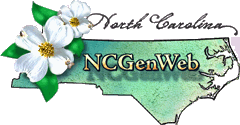Odell Community Has Colorful Background
by Randolph S. Hancock, The Daily Independent, October 9, 1955
submitted by Bill Furr
ODELL, Oct. 8 – Pioneer John Johnston really started something in this community. He came up over the rolling hills out of Virginia in company with his two brothers. It took a team of horses to haul his 340 pound frame! But he was a man among men!
He was a rugged man. And he had come to a rugged country. Indians tipped silently through the virgin forests of northwestern Cabarrus County. There were varmints, too: Catamounts, bears, wildcats and buffalo. John Johnston took the Indians, the catamounts, and the bears in stride. He was a man among men! He weighed 340 pounds!
He stepped down off the wagon, sucked in a lungful of the pine-scented air. The forest was quiet except for the bell-like tones of the woodthrush, the soft call of a joree. John Johnston liked all that he saw. He knew right off that he had found a country to fit his frame. He told his brothers they could continue on if they liked. And they did.
John Johnston put down his roots in the soil of Cabarrus. They were in fertile soil. He began to carve out a place for his cabin. The virgin forest fell before his axe. And No. 3 Township began to take shape, it was on its way.
Its growth was slow. Men who dared the great forests were few and far between in the 1700s. A man had to have a purpose as well as stamina to brave the wilds in those days! John Johnston had a purpose, and he was a man among men!
He stood tall, most seven feet, with a shock of sandy hair to accentuate his blue Irish eyes. His jaw was square, and his calloused hands were like hog hams. John Johnston was a man among men!
Northwest Cabarrus inched up the ladder of time. John Johnston soon had neighbors. Openings began to grow in the forest. Corn and cotton and peas and pumpkins, and hogs and cattle began to show in the clearings.
The community was takings shape. John Johnston’s neighbors were hard-working, solid citizens with a Presbyterian leaning. “In the early days,” said Mrs. John Bradford, 76, “we thought nothing of driving a horse and wagon over to Ramah church. We went, too, every Sunday unless we were sick.” But in those days people had fun, too. “We had our square dances,” Mrs. Bradford said. “But I never went to one of the all-night dances,” she added.
The trek to Ramah in Mecklenburg was continued until 1889 when a commission was appointed by Concord Presbytery to organize a church in the community. This was accomplished on Nov. 1, 1889 when the committee met in the old Deweese school building.
The committee was composed of: Rev. H. G. Gilliand, pastor of Poplar Tent: Rev. R. S. Arrowood, Bethpage pastor; Rev. John G. Anderson, pastor of Rock River; and Ruling Elder Nat Johnston. After hearing a sermon by the Rev. Mr. Anderson, the church was organized with 37 charter members. Sixteen came by certificate from Ramah church; 15 from Poplar Tent, one from Huntersville, and two by examination.
The charter members were: John W. Morrison. John Haves Johnson, Mrs. Carrie H. Overcash, Mrs. Bettie H. Chester, Andrew J. Hayes, Mrs. E. J. Hayes, Mrs. Jane Henderson, James R. Henderson. Mrs. M. J. Readling, Mrs. Nancy R. Mowrer, Miss Lizzie Mowrer, J. O. Mowrer, Mrs. Amanda Carrigan Fulham, Mrs. Sarah M. Hamilton, H. R. Hamilton, and Charles H. Hamilton. They were from Ramah church.
From Poplar Tent came: Nat Johnston, Mrs. Mary E. Johnston, John C. Johnston, Mrs. Clara I. Johnston. Charles L. Johnston. Bishop S. Johnston, Miss Ella L. Johnston. Miss Mary V. Johnston, Miss Jennie E. Johnston. John W. Johnston, Mrs. Nancy Johnston, Mrs. Margaret C. Bradford, Mrs. Sarah M. Bradford, J. A. Faggart and R. C. Harris.
From Bethpage came James N. Bell, Miss Margaret Bell and Miss Woddie Bell. Mrs. Margaret Johnston came from Huntersville, and John R. Bradford and D. Bruce Overcash were admitted on examination. The first member received into the church after its organization was Miss Emma Overcash.
Out of that list of rugged pioneers, three survive: They are, Charles L. Johnston, great grandson of John Johnston; Mrs. Lizzie Mowerer Hudson of Mooresville; and Mrs. Woodie Bell Ritch of Charlotte. Charles L. Johnston has served the church as a deacon for 51 years!
According to the church’s records, the first elders were Nat Johnston, grandfather of Charles L. Johnston and son of the first John Johnston; John Hayes Johnston and Charles Hamilton. C. H. Hamilton was elected clerk of sessions, John C. Johnston and John O. Mowerer were elected deacons.
The church needed a name. So the congregation took parts of the last names of two of the ministers who held services at the Deweese schoolhouse on alternate Sundays before the congregation was organized. They were H. G. Gilliand and R. S. Arrowood. Out of their names Gilwood Presbyterian church was born.
The present minister, the Rev. W. H. Matheson, lists 246 members of the church and 225 in the Sunday School. Present deacons of the church are Charles L. Johnston, A. H. Harris, Homer W. Johnston, Joe K. Bradford, J. Laurence Johnston, M. L. McCorkle, Wilson Johnston, James Brumley, Edgar Harwell, and Grady Seaford. Sunday School superintendent is James W. Atwell.
The outside world has felt the effects of Gilwood Presbyterian Church. From it have come ministers and missionaries and other Christian workers. The church history lists Thomas H. Hamilton and Samuel and Will Hoyt as former members of Gilwood who now are ministers. Young women now engaged “in full time Christian work” are Sarah Hamilton, Elizabeth Chester and Mary Margaret Harris. Continuing, says the church history, “even if we had a complete list it would take too long to name the officers and workers in other churches, Sunday Schools, and men’s and women’s organizations.” Out of the work of this church has been welded a community of neighbors.
A few years ago Mrs. John Bradford’s house was burned. It was a Saturday afternoon. “I was sitting here in my living room,” Mrs. Bradford said, “Some of the children saw ashes dropping down between the chimney and the ceiling. We spread the alarm and in a few minutes there were hundreds of people, it looked like, in the yard and in the road. But their efforts were futile. “There were too many rats nests and spider webs between the ceiling.” Mrs. Bradford said, “The fire found its way into this dry mass and it ate a hole through the house before any one could do anything.”
She said that practically everything was destroyed. “We had to move in with our children. People offered us a place to stay, but we decided to go with a so. That was a neighborly gesture that was well founded. “I want you to know,” said Mrs. Bradford, “that come Monday morning the yard was full of men. They brought tools with which to work and in a day, everything had been cleared away and the foundation for this house was ready to begin.”
The house went up. She said that one man gave lumber with which to rebuild the house. Many others gave of their time and skill in rebuilding the house. “I had people to give me $25 checks, others gave us furniture.” It was a revelation of neighborliness to hear Mrs. Bradford repeat the many things the people did for her in the unfortunate loss of her home.
Their acts reflect the spirit of the people of the Odell community, a community that took its name from a Concord educator, W. R. Odell for whom the present school was named. This school, one of Cabarrus County’s outstanding rural high schools, replaced the old one-room Deweese school where the Gilwood Presbyterian church got its start and where Charles L. Johnston, community patriarch, was exposed to the three R’s.
He said he didn’t get to go to school too much. He was needed at home, and boys being what they are, he didn’t insist on going to school. But he remembers a lot about that old school house. He remembers, too, a lot he was told about his great grandfather, John Johnston. “He was a big man,” said Mr. Johnston. “He stood tall among the timbers and he weighed 340 pounds.”
Mr. Johnston said his forebearer came to “this wilderness as a young man. It was early in the 1700’s, and he brought his two brothers with him. He decided to stay and his brothers wanted to go on to Mississippi. John Johnston built a log cabin and he got married. “He raised 14 children,” said Mr. Johnston, “There were nine girls, and five boys!” John Johnston was a man among men!
Nathaniel Johnston was a son of John. “I remember hearing my grandfather say that as a boy he could climb the tallest tree in the community and look about and he could count maybe one or two houses!”
Pioneer John Johnston really started something in Northwest Cabarrus County.


